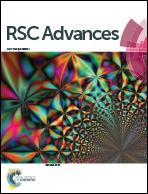Improving the performance of solid-state quantum dot-sensitized solar cells based on TiO2/CuInS2 photoelectrodes with annealing treatment†
Abstract
CuInS2 quantum dot (CIS QD)-sensitized solar cells (QDSSCs) with spiro-OMeTAD as the solid-state hole transport material were fabricated by using a successive ionic layer adsorption and reaction (SILAR) process. The structural, morphological, optical and photovoltaic characterizations of the composite films indicate the importance of thermal treatment in enhancing the performance of the solar cells. The results reveal that chalcopyrite CIS QDs of around 8 nm in size are distributed homogeneously over the surface of TiO2 particles and are well separated from each other under the proper annealing conditions. With increasing the temperature, the effect of annealing is to shift the absorption onset to longer wavelengths, thus improving the photocurrent substantially. It is also noteworthy that the annealing is beneficial for the efficient charge transport and the decreased charge recombination. Under simulated illumination (AM 1.5, 100 mW cm−2), the solid-state QDSSCs with distinct architectures deliver a maximum efficiency of 1.41% for the solar cell fabricated with a pristine CIS QD-sensitized TiO2 photoelectrode annealed up to 450 °C.


 Please wait while we load your content...
Please wait while we load your content...